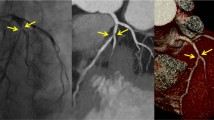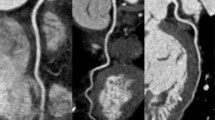Abstract
Objectives
The objective was to prospectively investigate the diagnostic accuracy of high-pitch (HP) dual-source computed tomography coronary angiography (CTCA) compared with catheter coronary angiography (CCA) for the diagnosis of significant coronary stenoses.
Methods
Thirty-five patients (seven women; mean age 62 ± 8 years) underwent both CTCA and CCA. CTCA was performed with a second-generation dual-source CT system permitting data acquisition at an HP of 3.4. Patients with heart rates >60 bpm were excluded from study enrolment. All coronary segments were evaluated by two blinded and independent observers with regard to image quality on a four-point scale (1: excellent to 4: non-diagnostic) and for the presence of significant coronary stenoses (defined as diameter narrowing exceeding 50%). CCA served as the standard of reference. Radiation dose values were calculated using the dose-length product.
Results
Diagnostic image quality was found in 99% of all segments (455/459). Non-diagnostic image quality occurred in a single patient with a sudden increase in heart rate immediately before and during CTCA. Taking segments with non-evaluative image quality as positive for disease, the sensitivity, specificity and positive and negative predictive values were 94, 96, 80 and 99% per segment and 100, 91, 88 and 100% per patient. The effective radiation dose was on average 0.9 ± 0.1 mSv.
Conclusion
In patients with heart rates ≤60 bpm, CTCA using the HP mode of the dual-source CT system is associated with high diagnostic accuracy for the assessment of coronary artery stenoses at sub-milliSievert doses.



Similar content being viewed by others
References
Brodoefel H, Burgstahler C, Tsiflikas I et al (2008) Dual-source CT: effect of heart rate, heart rate variability, and calcification on image quality and diagnostic accuracy. Radiology 247:346–355
Johnson TR, Nikolaou K, Busch S et al (2007) Diagnostic accuracy of dual-source computed tomography in the diagnosis of coronary artery disease. Invest Radiol 42:684–691
Leschka S, Alkadhi H, Plass A et al (2005) Accuracy of MSCT coronary angiography with 64-slice technology: first experience. Eur Heart J 26:1482–1487
Raff GL, Gallagher MJ, O’Neill WW et al (2005) Diagnostic accuracy of noninvasive coronary angiography using 64-slice spiral computed tomography. J Am Coll Cardiol 46:552–557
Ropers U, Ropers D, Pflederer T et al (2007) Influence of heart rate on the diagnostic accuracy of dual-source computed tomography coronary angiography. J Am Coll Cardiol 50:2393–2398
Scheffel H, Alkadhi H, Plass A et al (2006) Accuracy of dual-source CT coronary angiography: first experience in a high pre-test probability population without heart rate control. Eur Radiol 16:2739–2747
Weustink AC, Meijboom WB, Mollet NR et al (2007) Reliable high-speed coronary computed tomography in symptomatic patients. J Am Coll Cardiol 50:786–794
Miller JM, Dewey M, Vavere AL et al (2009) Coronary CT angiography using 64 detector rows: methods and design of the multi-centre trial CORE-64. Eur Radiol 19:816–828
Leber AW, Knez A, von Ziegler F et al (2005) Quantification of obstructive and nonobstructive coronary lesions by 64-slice computed tomography: a comparative study with quantitative coronary angiography and intravascular ultrasound. J Am Coll Cardiol 46:147–154
Mollet NR, Cademartiri F, van Mieghem CA et al (2005) High-resolution spiral computed tomography coronary angiography in patients referred for diagnostic conventional coronary angiography. Circulation 112:2318–2323
Pugliese F, Mollet NR, Runza G et al (2006) Diagnostic accuracy of non-invasive 64-slice CT coronary angiography in patients with stable angina pectoris. Eur Radiol 16:575–582
Alkadhi H (2009) Radiation dose of cardiac CT–what is the evidence? Eur Radiol 19:1311–1315
Achenbach S, Giesler T, Ropers D et al (2001) Detection of coronary artery stenoses by contrast-enhanced, retrospectively electrocardiographically-gated, multislice spiral computed tomography. Circulation 103:2535–2538
Hausleiter J, Meyer T, Hermann F et al (2009) Estimated radiation dose associated with cardiac CT angiography. JAMA 301:500–507
Leschka S, Scheffel H, Desbiolles L et al (2007) Image quality and reconstruction intervals of dual-source CT coronary angiography: recommendations for ECG pulsing windowing. Invest Radiol 42:543–549
Alkadhi H, Scheffel H, Desbiolles L et al (2008) Dual-source computed tomography coronary angiography: influence of obesity, calcium load, and heart rate on diagnostic accuracy. Eur Heart J 29:766–776
Scheffel H, Alkadhi H, Leschka S et al (2008) Low-dose CT coronary angiography in the step-and-shoot mode: diagnostic performance. Heart 94:1132–1137
Stolzmann P, Leschka S, Scheffel H et al (2008) Dual-source CT in step-and-shoot mode: noninvasive coronary angiography with low radiation dose. Radiology 249:71–80
Achenbach S, Marwan M, Schepis T et al (2009) High-pitch spiral acquisition: a new scan mode for coronary CT angiography. J Cardiovasc Comput Tomogr 3:117–121
Diamond GA, Forrester JS (1979) Analysis of probability as an aid in the clinical diagnosis of coronary-artery disease. N Engl J Med 300:1350–1358
Austen WG, Edwards JE, Frye RL et al (1975) A reporting system on patients evaluated for coronary artery disease. Report of the Ad Hoc Committee for Grading of Coronary Artery Disease, Council on Cardiovascular Surgery, American Heart Association. Circulation 51:5–40
Menzel HG, Schibilla H, Teunen D (eds) (2000) European guidelines on quality criteria for computed tomography. Publication no. EUR 16262 EN. European Commission, Luxembourg
Ong TK, Chin SP, Liew CK et al (2006) Accuracy of 64-row multidetector computed tomography in detecting coronary artery disease in 134 symptomatic patients: influence of calcification. Am Heart J 151(1323):e1321–e1326
Rixe J, Rolf A, Conradi G et al (2008) Image quality on dual-source computed-tomographic coronary angiography. Eur Radiol 18:1857–1862
Husmann L, Leschka S, Desbiolles L et al (2007) Coronary artery motion and cardiac phases: dependency on heart rate – implications for CT image reconstruction. Radiology 245:567–576
Author information
Authors and Affiliations
Corresponding author
Rights and permissions
About this article
Cite this article
Leschka, S., Stolzmann, P., Desbiolles, L. et al. Diagnostic accuracy of high-pitch dual-source CT for the assessment of coronary stenoses: first experience. Eur Radiol 19, 2896–2903 (2009). https://doi.org/10.1007/s00330-009-1618-9
Received:
Revised:
Accepted:
Published:
Issue Date:
DOI: https://doi.org/10.1007/s00330-009-1618-9




